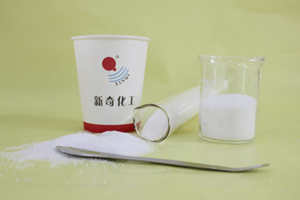The viscosity of polyacrylamide solution mainly reflects the internal friction resistance generated by the flow or relative movement between liquid molecules. The internal friction resistance is related to the structure of the polymer, the properties of the solvent, the concentration of the solution, and the temperature and pressure. The larger its value, the greater the viscosity of the solution.
1. The effect of temperature on the viscosity of polyacrylamide
Temperature is a reflection of the intensity of the irregular thermal motion of molecules. The movement of molecules must overcome the interaction between molecules, and the interaction between molecules, such as intermolecular hydrogen bonds, internal friction, diffusion, molecular chain orientation, entanglement, etc., directly affect the viscosity. Therefore, the viscosity of polymer solutions will change with temperature. The effect of temperature change on the viscosity of polymer solutions is significant. The viscosity of polyacrylamide solution decreases with the increase of temperature. The reason is that the dispersed phase particles of the polymer solution entangle with each other to form a network structure polymer. The higher the temperature, the easier it is to destroy the network structure, so its viscosity decreases.
2. Effect of hydrolysis time on viscosity of polyacrylamide
The viscosity of polyacrylamide solution changes with the extension of hydrolysis time. The shorter the hydrolysis time, the lower the viscosity, which may be due to the fact that the polymer has not had time to form a network structure; if the hydrolysis time is too long, the viscosity decreases, which is due to the loosening of the structure of polyacrylamide in the solution. After partially hydrolyzed polyacrylamide is dissolved in water, it dissociates into negatively charged macromolecules. The electrostatic repulsion between molecules and the anionic repulsion between different chain segments on the same molecule cause the molecules to stretch in the solution and can make the molecules entangled with each other. This is why partially hydrolyzed polyacrylamide can significantly increase the viscosity of its solution.
3. Effect of mineralization on viscosity of polyacrylamide
The number of cationic groups in the molecular chain of polyacrylamide is larger than that of anionic groups, the net charge is larger, and the polarity is larger. H2O is a polar molecule. According to the principle of like dissolves like, the polymer has good water solubility and high intrinsic viscosity. With the increase of mineral content, the positive electrostatic charge is surrounded by anions to form an ionic atmosphere, which combines with the surrounding positive electrostatic charge, and the polarity of the polymer solution decreases and the viscosity decreases. With the increase of mineral concentration, the positive and negative ion groups form intramolecular or intermolecular hydrogen bond association (causing the solubility of the polymer in water to decrease). At the same time, the added salt ions shield the positive and negative charges, break up the association between positive and negative ions, and destroy the formed salt bonds (causing the solubility of the polymer in water to increase). These two effects compete with each other, so that the viscosity of the polymer solution remains small at a higher salt concentration (>0.06 mol/L).
4. Effect of molecular weight on viscosity of polyacrylamide
The viscosity of polyacrylamide solution increases with the increase of polymer molecular weight. This is because the viscosity of polymer solution is generated by the interaction between molecules during molecular motion. When the relative molecular mass of the polymer is about 106, the polymer coils begin to interpenetrate each other, which is enough to affect the scattering of light. When the content is slightly higher, the mechanical entanglement is enough to affect the viscosity. When the content is quite low, the polymer solution can be regarded as a network structure, and the mechanical entanglement and hydrogen bonds between the chains together form the nodes of the network. When the content is higher, the solution contains many chain-chain contact points, making the polymer solution gel-like. Therefore, the larger the relative molecular mass of the polymer, the easier it is for the molecules to form chain entanglements, and the greater the viscosity of the solution.

